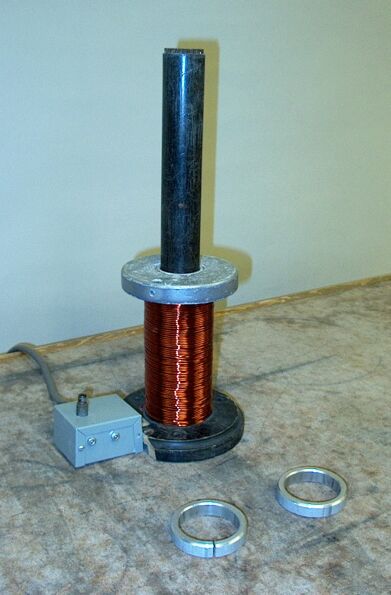
The coil in the photograph (an Elihu Thomson coil) is wound around the bottom half of a core made of a bundle of iron rods. A momentary-contact pushbutton switch on the box attached to its base allows you to apply AC line voltage to the coil. Place the solid aluminum ring over the core (to rest on the coil). When you press the button, the ring flies upwards about two feet. Now place the ring with the slot cut in it over the core. When you press the button, nothing happens.
This demonstration illustrates Lenz’s law, which states that when a changing magnetic flux induces a current in a loop of wire, the induced current flows in such a direction as to oppose the change that is producing it. (Strictly speaking, the changing magnetic flux induces an electromotive force (emf), which causes a current to flow. It is not uncommon, however, for people to assume that this is understood, and to speak of an induced current.) A current flowing in a loop produces a magnetic dipole field, similar to that of a bar magnet. (See demonstration 68.13 -- Right-hand rule model.) This magnetic field opposes the (change in) the magnetic field that induced the current that produced it. In demonstration 72.09 – Lenz’s law, you provide the changing flux by moving a cow magnet into and out of a hanging ring. In this demonstration, the changing flux arises from the oscillating magnetic field produced by the alternating current in the coil. Because the voltage across the wall outlet oscillates (roughly sinusoidally), so does the current through the coil, and the magnetic field associated with it thus oscillates, growing and shrinking, then reversing direction, every half cycle. This oscillating magnetic field induces in the (solid) ring an oscillating emf, which produces an oscillating current. For the ring sitting on the coil, this current is always in the direction for which the associated magnetic field opposes that produced by the coil. The two fields thus repel each other, and the ring flies upwards. If you try this with the ring that has a cut in it, the magnetic field of the coil induces the same oscillating emf in the ring, but because of the cut, a current cannot flow around the ring, and there is no associated magnetic field. Thus, when you push the button, the ring just sits there.